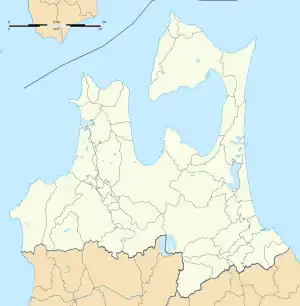Hachinohe Station 八戸駅 | |||||||||||||||||||||||||||||||||||
|---|---|---|---|---|---|---|---|---|---|---|---|---|---|---|---|---|---|---|---|---|---|---|---|---|---|---|---|---|---|---|---|---|---|---|---|
| Tōhoku Shinkansen / Regional rail station | |||||||||||||||||||||||||||||||||||
.jpg.webp) The east entrance of Hachinohe Station in July 2013 | |||||||||||||||||||||||||||||||||||
| General information | |||||||||||||||||||||||||||||||||||
| Location | Shiriuchi, Hachinohe, Aomori Prefecture 039-1101 Japan | ||||||||||||||||||||||||||||||||||
| Coordinates | 40°30′34″N 141°25′51″E / 40.509394°N 141.430736°E | ||||||||||||||||||||||||||||||||||
| Operated by | |||||||||||||||||||||||||||||||||||
| Line(s) | |||||||||||||||||||||||||||||||||||
| Platforms | 1 side + 4 island platforms | ||||||||||||||||||||||||||||||||||
| Connections | |||||||||||||||||||||||||||||||||||
| Construction | |||||||||||||||||||||||||||||||||||
| Structure type | Elevated | ||||||||||||||||||||||||||||||||||
| Other information | |||||||||||||||||||||||||||||||||||
| Status | Staffed (Midori no Madoguchi) | ||||||||||||||||||||||||||||||||||
| Website | Official website | ||||||||||||||||||||||||||||||||||
| History | |||||||||||||||||||||||||||||||||||
| Opened | 1 September 1891 | ||||||||||||||||||||||||||||||||||
| Rebuilt | 2002 | ||||||||||||||||||||||||||||||||||
| Previous names | Shiriuchi (until 1971) | ||||||||||||||||||||||||||||||||||
| Passengers | |||||||||||||||||||||||||||||||||||
| FY2015 | 4,491 daily (JR East portion only) | ||||||||||||||||||||||||||||||||||
| Services | |||||||||||||||||||||||||||||||||||
| |||||||||||||||||||||||||||||||||||
| Location | |||||||||||||||||||||||||||||||||||
 Hachinohe Station Location within Aomori Prefecture  Hachinohe Station Hachinohe Station (Japan) | |||||||||||||||||||||||||||||||||||

Hachinohe Station (八戸駅, Hachinohe-eki) is a railway station operated by the East Japan Railway Company (JR East) in Hachinohe, Aomori, Japan.
Lines
Hachinohe Station is served by the high-speed Tōhoku Shinkansen line between Tokyo and Shin-Aomori, and forms the starting point of the Hachinohe Line to Kuji. Local services are operated by the third sector Aoimori Railway on the section of the former JR Tōhoku Main Line between Metoki and Aomori. It is one of six principal stations served by the Aoimori Railway Line[1] and is the easternmost high-speed Shinkansen railway station in Japan.
Station layout
Hachinohe is an elevated station with one side platform and two island platforms serving five tracks for regular services, and two island platforms serving four tracks for Tōhoku Shinkansen services. The station has a Midori no Madoguchi staffed ticket office.
Platforms
| 1 | ■ Hachinohe Line | for Hon-Hachinohe, Same, Taneichi, and Kuji |
| 2 | ■ Hachinohe Line | for Hon-Hachinohe, Same, Taneichi, and Kuji |
| ■ Aoimori Railway Line | for Sannohe, Ninohe, and Morioka Misawa, Noheji, and Aomori | |
| 3-5 | ■ Aoimori Railway Line | for Sannohe, Ninohe, and Morioka Misawa, Noheji, and Aomori |
| 11/12 | ■ Tohoku Shinkansen | for Morioka, Sendai, and Tokyo |
| 13/14 | ■ Tohoku Shinkansen | for Shin-Aomori and Shin-Hakodate-Hokuto |
History
The station began operation as Shiriuchi Station (尻内駅) on the Nippon Railway on September 1, 1891.[2] Initially, the construction of a railroad close to the coast was opposed by the Imperial Japanese Army for defensive purposes, so the station was constructed at a considerable distance inland from the town center. The Hachinohe Line began operations on January 4, 1894, from Hachinohe Station. The Nippon Railway was nationalized on November 1, 1906, and Shiriuchi Station became a station on the Japanese Government Railways (JGR), which became the Japanese National Railways (JNR) after World War II. From 1929 to 1969, the now-defunct Nambu Railway also had its terminus at Shiriuchi Station. On April 1, 1971, Shiriuchi Station was renamed Hachinohe Station. The station previously named Hachinohe Station was renamed Hon-Hachinohe Station.[2] Freight operations were transferred to the Hachinohe Freight Terminal later that year and were discontinued completely from 1986. With the privatization of JNR on April 1, 1987, the station came under the operational control of JR East.[2]
A new station building was opened on July 1, 2002, and Tōhoku Shinkansen services began operation from December 12, 2002, with operations of the Tōhoku Main Line from Hachinohe to the border of Iwate Prefecture transferred to the new Aoimori Railway. Following the opening of the Tōhoku Shinkansen extension to Shin-Aomori on December 4, 2010, all Tōhoku Main Line local services through the station were transferred to the Aoimori Railway.
Passenger statistics
In fiscal 2015, the JR East portion of the station was used by an average of 4,491 passengers daily (boarding passengers only).[3]
Connecting bus routes
Route buses
- JR Bus Tōhoku
- For Lake Towada
- Nanbu Bus
- For Gonohe
- For Konakano Bus Center via Yōka-machi
- Towada Kanko Bus
- Hachonohe City Bus
- For Asahigaoka Bus office via Mikka-machi
Highway buses
- Sirius; For Ikebukuro Station and Tokyo Station[4]
- Shimokita; For Ōmiya Station (Saitama) and Shinjuku Station[4]
- Enburi; For Shinjuku Station and Tokyo Station[5]
- For Karumai
Surrounding area
- Hachinohe Station building "Umineko plaza"
- Hotel Mets Hachinohe
- Hachinohe area stockbroker Sangho Shinko center "Yutori"
- Hachinohe-Ekimae post office
- Hachinohe Red Cross hospital
- Flat Hachinohe (indoor ice arena)
See also
References
- ↑ "Aoimori Railway Line Route and Fares" (pdf). September 2019. Retrieved 19 February 2020.
- 1 2 3 Ishino, Tetsu, ed. (1998). 停車場変遷大辞典 国鉄・JR編 [Station Transition Directory - JNR/JR] (in Japanese). Vol. II. Japan: JTB. pp. 416–417. ISBN 4-533-02980-9.
- ↑ 各駅の乗車人員 (2015年度) [Station passenger figures (Fiscal 2015)] (in Japanese). Japan: East Japan Railway Company. 2016. Retrieved 11 December 2016.
- 1 2 "八戸・十和田・七戸/三沢・野辺地・むつ 〔シリウス号/しもきた号〕 | 高速バス | 国際興業バス". 5931bus.com (in Japanese). Kokusai Kogyo Co., Ltd. Retrieved 2016-02-07.
- ↑ えんぶり号 - 弘南バス株式会社. www.konanbus.com (in Japanese). Konan Bus. Co.Ltd. Retrieved 2016-02-07.
External links
- Hachinohe Station map
- JR East station information page (in Japanese)